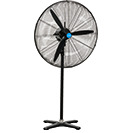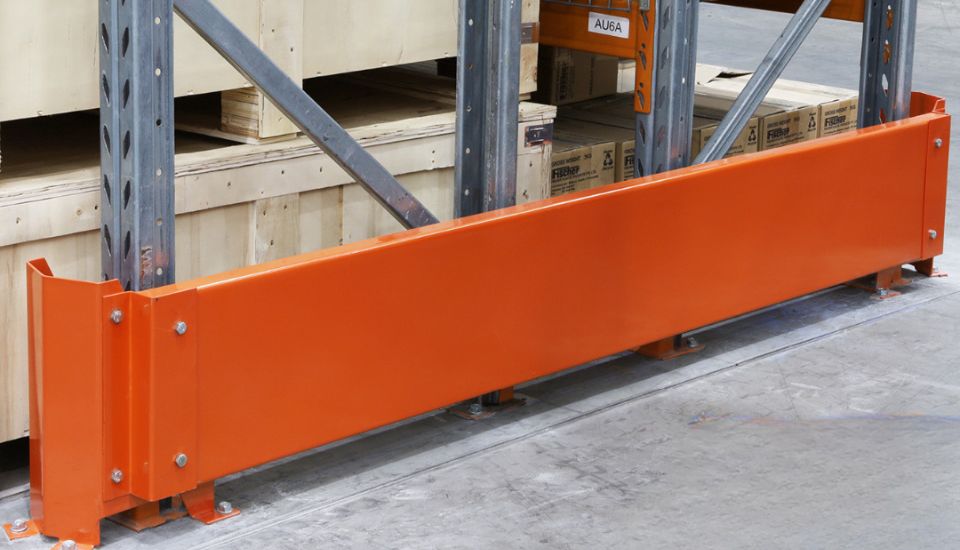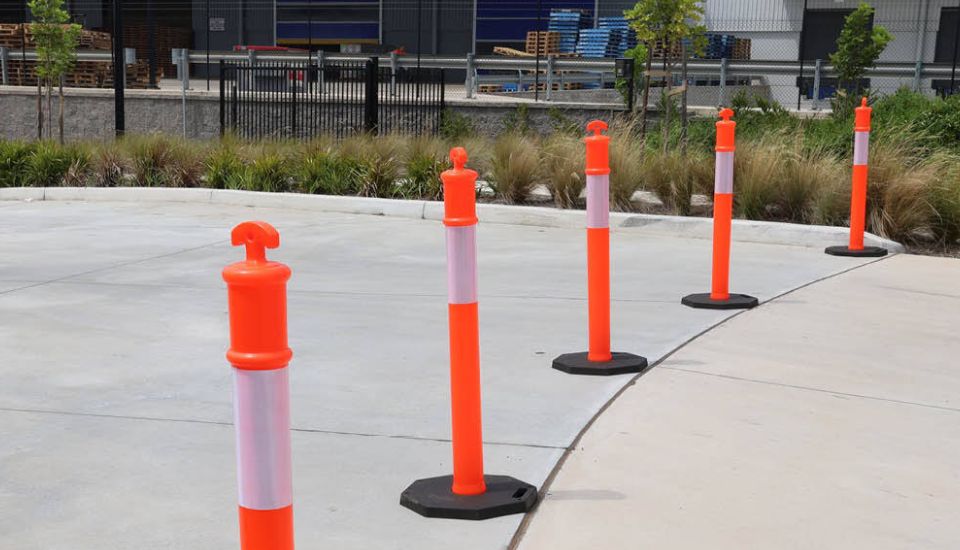5 Key Roles of Safety Barriers in Warehouse Environments
Date Posted:19 September 2025
Warehouses are high-risk environments. Safety barriers prevent accidents, protect equipment, and keep your team confident. Learn more about the role of safety barriers in these workplaces.
Protecting Workers and Equipment: The Role of Safety Barriers in Warehouses
In a fast-paced warehouse environment, safety is a top priority. Workers are constantly moving, handling goods, operating machinery, and interacting with heavy-duty equipment. With so many potential hazards, maintaining a safe and efficient workplace is essential to ensuring productivity and reducing risks. One of the most effective ways to achieve this is by implementing safety barriers.
Safety barriers and security bollards are reliable workplace safety equipment and serve as both physical and psychological safeguards, helping to protect workers, equipment, and infrastructure from harm. In this blog, we will explore the crucial role of safety barriers in warehouses and how they contribute to a safer, more organised, and productive workplace.
Why Safety Barriers Are Essential in Warehouses
Warehouses are busy environments where forklifts, pallet jacks, trolleys and other material handling equipment constantly move products, materials, and supplies. The presence of pedestrians, trucks, and forklifts in close proximity increases the risk of accidents. Safety barriers provide a physical separation between workers and potentially dangerous machinery or hazardous areas, significantly reducing the chances of accidents.
In addition to worker protection, safety barriers also play a key role in safeguarding valuable equipment and infrastructure. Whether it's the shelving systems, machinery, or loading docks, barriers act as a protective buffer, preventing costly damages that can disrupt operations.
5 Key Roles of Safety Barriers in Warehouse Environments
1. Preventing Worker Injuries
The most significant role of safety barriers in a warehouse is to protect employees from accidents and injuries. Workers are exposed to various hazards, from moving forklifts to falling objects, and it is crucial to create clear boundaries to keep them safe.
How Safety Barriers Protect Workers:
-
Separate Pedestrian and Vehicle Traffic: Safety barriers can create clear pathways for pedestrians and designated zones for forklifts and other vehicles. This separation ensures that workers are not accidentally run over or caught in traffic between moving machinery.
-
Preventing Collisions: In a warehouse, workers may unknowingly walk into the path of a moving forklift or other machinery. Safety barriers act as a physical reminder of the hazards in the area, reducing the risk of collisions and injuries.
-
Protecting from Falling Objects: In areas where goods are stacked at height, the potential for items to fall is high. Safety barriers help prevent workers from being in the direct line of sight beneath shelves or racks, ensuring they are protected from falling objects.
While safety barriers aren’t traditionally classified as material handling equipment, they play a critical supporting role in material handling environments. Barriers help protect workers, racking systems, and machinery, ensuring that goods can be moved and stored safely. Just like workplace first aid kits, which provides an essential backup when accidents occur, safety barriers form part of the wider safety infrastructure that keeps warehouses compliant, efficient, and productive.
2. Safeguarding Equipment and Infrastructure
Warehouses contain valuable equipment and infrastructure that are essential to operations. However, these assets are at risk of damage due to collisions or impacts from moving machinery, such as forklifts or pallet jacks. Safety barriers play a crucial role in protecting both the equipment and the building structure from costly damage.
Protecting Equipment:
-
Racking Systems: Forklifts and other equipment can occasionally crash into shelving systems, causing damage to the racks and potentially resulting in the collapse of stored goods. By placing barriers around racking systems, the risk of such incidents is reduced.
-
Machinery Protection: Warehouses often use high-cost machinery, such as conveyors and automated systems, which are vulnerable to impact. Installing safety barriers around these areas ensures that machinery remains in good condition and operational, reducing the need for costly repairs.
-
Warehouse Infrastructure: Columns, walls, and loading docks are also susceptible to accidental damage from forklifts or other vehicles. Safety barriers can help protect these vital infrastructure components from wear and tear, helping to maintain the longevity of your warehouse.
By preventing collisions and impacts, safety barriers help protect not only the workers but also the expensive assets and infrastructure that make your warehouse operations possible.
3. Optimising Workflow and Efficiency
While safety barriers primarily serve to protect workers and equipment, they also play an important role in improving workflow and efficiency within the warehouse. When employees have clear boundaries and designated work zones, it reduces confusion and increases productivity.
How Safety Barriers Enhance Workflow:
-
Improving Traffic Flow: Safety barriers help direct the movement of traffic within the warehouse. By establishing designated lanes for pedestrians and vehicles, barriers prevent congestion, reduce bottlenecks, and ensure smooth operations throughout the warehouse.
-
Organising Workspaces: In a busy warehouse, a well-organised environment is essential. Safety barriers help define different work zones, including storage areas, loading docks, and machinery zones, ensuring that workers know where to operate and where to avoid.
-
Enhancing Efficiency: By preventing accidents and minimising distractions, safety barriers allow employees to focus on their tasks, resulting in faster and more efficient operations.
With a well-organised and efficient layout, warehouses can handle high volumes of work without sacrificing safety, ultimately boosting productivity and reducing operational costs.
4. Ensuring Compliance with Safety Standards
Workplace safety regulations are designed to ensure that businesses provide a safe environment for their employees. In Australia, regulations such as the Work Health and Safety Act 2011 require employers to implement appropriate safety measures to prevent injuries and accidents. Safety barriers are a key part of meeting these regulatory requirements and maintaining compliance.
How Safety Barriers Help with Compliance:
-
Meeting Legal Obligations: Installing safety barriers around hazardous areas ensures that a warehouse complies with the relevant health and safety standards. This reduces the risk of penalties or legal actions due to non-compliance.
-
Protecting Workers: By ensuring that hazardous areas are properly barricaded and that pedestrian walkways are clearly defined, safety barriers demonstrate that an organisation is prioritising employee protection, which can prevent accidents and injuries.
-
Reducing Liability: Having safety barriers in place helps minimise the risk of accidents, which can reduce potential liability claims. This can save your business money in legal fees, compensation, and insurance premiums.
In addition to barriers, workplace safety signage also play a vital role in compliance. Clear signage ensures that employees are aware of hazards, designated walkways, and emergency procedures, reinforcing the effectiveness of safety barriers and helping businesses meet their WHS obligations.
By investing in safety barriers, warehouses can not only ensure the safety of their workers but also avoid costly fines and legal complications.
5. Psychological Benefits: Creating a Safe Work Environment
The presence of safety barriers in a warehouse does more than just physically separate hazardous areas. It also provides a psychological sense of safety to workers. When employees know that appropriate measures are in place to protect them, their stress levels decrease, and they can focus better on their work.
Psychological Benefits:
-
Enhanced Confidence: When workers see safety barriers separating dangerous areas from pedestrian zones, they are more likely to feel confident in their ability to work safely and efficiently.
-
Reduced Anxiety: The clear visual indicators of safety barriers help reduce anxiety about potential hazards. Knowing that certain areas are off-limits and that dangerous machinery is clearly separated from pedestrian zones makes the work environment less stressful.
-
Higher Morale: Employees who feel safe and valued are more likely to have higher morale, which can lead to greater job satisfaction and higher productivity.
Safety barriers not only physically protect workers but also contribute to their emotional wellbeing, fostering a positive work environment where employees are motivated and engaged. When combined with PPE, protective clothing, and other safety gear, barriers create a comprehensive safety culture that ensures workers feel secure, supported, and able to perform at their best.
Types of Safety Barriers for Warehouse Protection
There are various types of safety barriers, each designed for different purposes. The choice of barrier depends on the nature of the warehouse, the specific risks present, and the layout of the space.
Common Types of Safety Barriers:
-
Traffic Barriers: These are designed to separate vehicle traffic from pedestrian walkways. They are ideal for high-traffic areas where forklifts and pedestrians need to operate in close proximity.
-
Rack Protectors: These barriers are specifically designed to protect racking systems from forklift impacts, helping to prevent costly damage to storage units.
-
Edge Protection Barriers: Installed around loading docks, mezzanines, or elevated platforms, these barriers protect workers from falling and help prevent accidents.
-
Column Protectors: These are used to safeguard structural columns in a warehouse from damage caused by collisions with forklifts or other equipment.
-
Fencing and Guardrails: These are ideal for securing restricted areas and providing a physical boundary to protect high-risk zones in the warehouse.
Each of these barriers serves a unique function and can be strategically placed to address specific hazards within the warehouse.
Protect Your Warehouse with Safety Barriers
Safety barriers are an indispensable part of modern warehouse operations. They protect workers from potential injuries, safeguard valuable equipment, enhance workflow, and ensure compliance with safety regulations. Moreover, by creating a more organised and safer work environment, safety barriers boost worker morale and contribute to overall efficiency. Investing in high-quality safety barriers is a proactive way to reduce risks, prevent accidents, and protect both human and material assets in your warehouse.
At Verdex, we provide a range of durable and reliable safety barriers designed to meet the specific needs of your warehouse operations. Whether you need traffic barriers, rack protectors, or edge protection, our solutions can help you create a safer and more efficient workplace. Learn more by reaching out to us by:
-
Emailing us at sales@verdex.com.au
-
Filling out our contact form
By prioritising safety and investing in the right protective measures, you can ensure that your warehouse runs smoothly, your workers stay safe, and your operations remain efficient.






















































































 Trolleys & Hand Trucks
Trolleys & Hand Trucks Cage Trolleys
Cage Trolleys Cleaning Carts & Trolleys
Cleaning Carts & Trolleys Construction Trolleys
Construction Trolleys Custom Trolleys
Custom Trolleys Hand Trucks & Dollies
Hand Trucks & Dollies Laundry/Linen Trolleys
Laundry/Linen Trolleys Lifting Trolleys
Lifting Trolleys Order Picking Trolleys
Order Picking Trolleys Panel Cart Trolleys
Panel Cart Trolleys Platform Trolleys
Platform Trolleys Powered Trolleys
Powered Trolleys Shelf & Tiered Trolleys
Shelf & Tiered Trolleys Shopping Trolleys
Shopping Trolleys Stainless Steel Trolleys
Stainless Steel Trolleys Tool Trolleys
Tool Trolleys Utility & Service Carts
Utility & Service Carts Lifting & Handling Equipment
Lifting & Handling Equipment Forklift Attachments
Forklift Attachments Jib Attachments
Jib Attachments Lifting Hoists & Pallet Hooks
Lifting Hoists & Pallet Hooks Load Skates & Tow Tugs
Load Skates & Tow Tugs Manual Stackers & Lifters
Manual Stackers & Lifters Pallet Jacks
Pallet Jacks Pallet Lifters
Pallet Lifters Pallet Rotators & Dispenser
Pallet Rotators & Dispenser Powered Pallet Trucks & Electric Lifters
Powered Pallet Trucks & Electric Lifters Scissor Lift Trolleys and Tables
Scissor Lift Trolleys and Tables Conveyor Equipment
Conveyor Equipment Conveyor Frames & Stands
Conveyor Frames & Stands Roller & Skate Conveyors
Roller & Skate Conveyors Ladders & Access Equipment
Ladders & Access Equipment Container & Yard Ramps
Container & Yard Ramps Ladders & Step Stools
Ladders & Step Stools Work Platforms & Crane Cages
Work Platforms & Crane Cages Drum Handling Equipment
Drum Handling Equipment Drum Storage & Bunding
Drum Storage & Bunding Drum Trolleys & Lifters
Drum Trolleys & Lifters Forklift Drum Handling
Forklift Drum Handling Waste Handling & Bins
Waste Handling & Bins Bin Lifters & Tippers
Bin Lifters & Tippers Plastic Waste & Wheelie Bins
Plastic Waste & Wheelie Bins Steel Waste & Tipping Bins
Steel Waste & Tipping Bins Waste Carts
Waste Carts Dangerous Goods Storage & Spillage
Dangerous Goods Storage & Spillage Aerosol Cans Storage Cages
Aerosol Cans Storage Cages Bunded Pallets & Storage
Bunded Pallets & Storage Corrosive Goods Storage Cabinets
Corrosive Goods Storage Cabinets DG Storage & Trolleys
DG Storage & Trolleys Flammable Liquid Cabinets
Flammable Liquid Cabinets Forklift Gas Storage Cages
Forklift Gas Storage Cages Site Storage
Site Storage Spill Kits
Spill Kits Shelving & Storage Equipment
Shelving & Storage Equipment Stillage & Transport Cages
Stillage & Transport Cages 750 Series Cage Configurations
750 Series Cage Configurations Heavy Duty Cabinets
Heavy Duty Cabinets Heavy Duty Shelving
Heavy Duty Shelving Mega Bins & Pallets
Mega Bins & Pallets Packing & Workbenches
Packing & Workbenches Parts Trays & Stor-Pak Bins
Parts Trays & Stor-Pak Bins Pegboard & Louvre Panels
Pegboard & Louvre Panels Plastic Bins & Crates
Plastic Bins & Crates Plastic Handling Solutions Bins
Plastic Handling Solutions Bins Plastic Pallets
Plastic Pallets Stack & Nest Bins
Stack & Nest Bins Pallet Racking Accessories
Pallet Racking Accessories Workplace Equipment
Workplace Equipment Modular Workbenches
Modular Workbenches Electric Height-Adjustable Workbenches
Electric Height-Adjustable Workbenches Floor Matting
Floor Matting General Workplace Equipment
General Workplace Equipment Industrial Weighing Scales
Industrial Weighing Scales Packaging Machinery
Packaging Machinery Stationery Cupboards
Stationery Cupboards Storage and Stillage Cages
Storage and Stillage Cages Tool Trolleys
Tool Trolleys Tooling Cabinets
Tooling Cabinets Workshop Fans and Coolers
Workshop Fans and Coolers Safety Barriers, PPE & Signage
Safety Barriers, PPE & Signage Barriers & Bollards
Barriers & Bollards First Aid Equipment
First Aid Equipment Gloves, Knives and PPE
Gloves, Knives and PPE Signage
Signage Cleaning & Site Supplies
Cleaning & Site Supplies Cleaning Equipment
Cleaning Equipment Cleaning Trolleys
Cleaning Trolleys Rubbish Bins
Rubbish Bins Signs & Traffic Supplies
Signs & Traffic Supplies Construction Equipment
Construction Equipment Construction Trolleys
Construction Trolleys Waste Handling
Waste Handling General Site Equipment
General Site Equipment Concrete Equipment
Concrete Equipment Site Storage
Site Storage Lifting Equipment
Lifting Equipment











